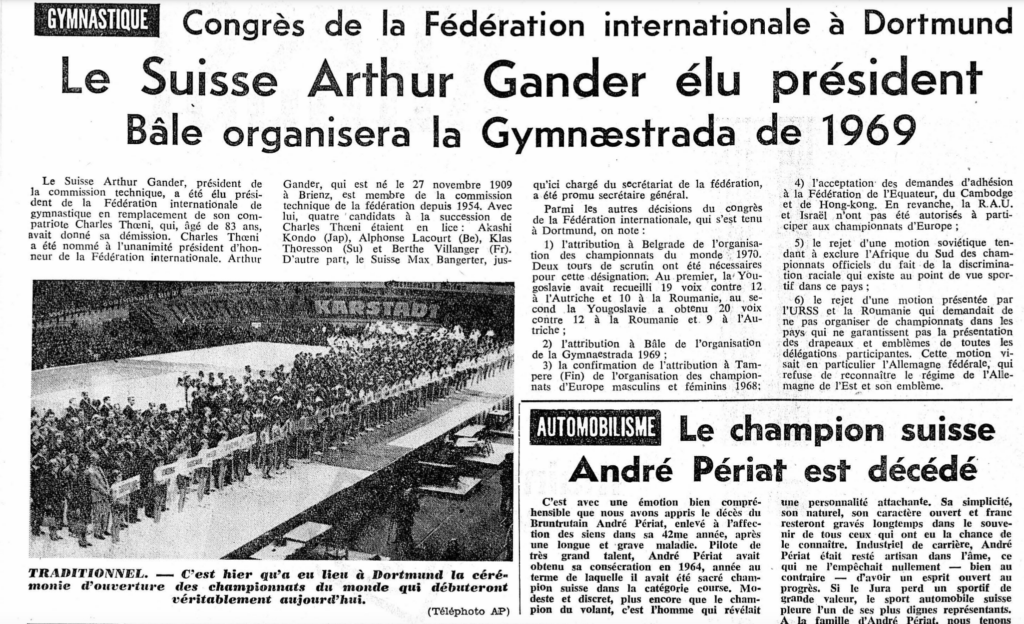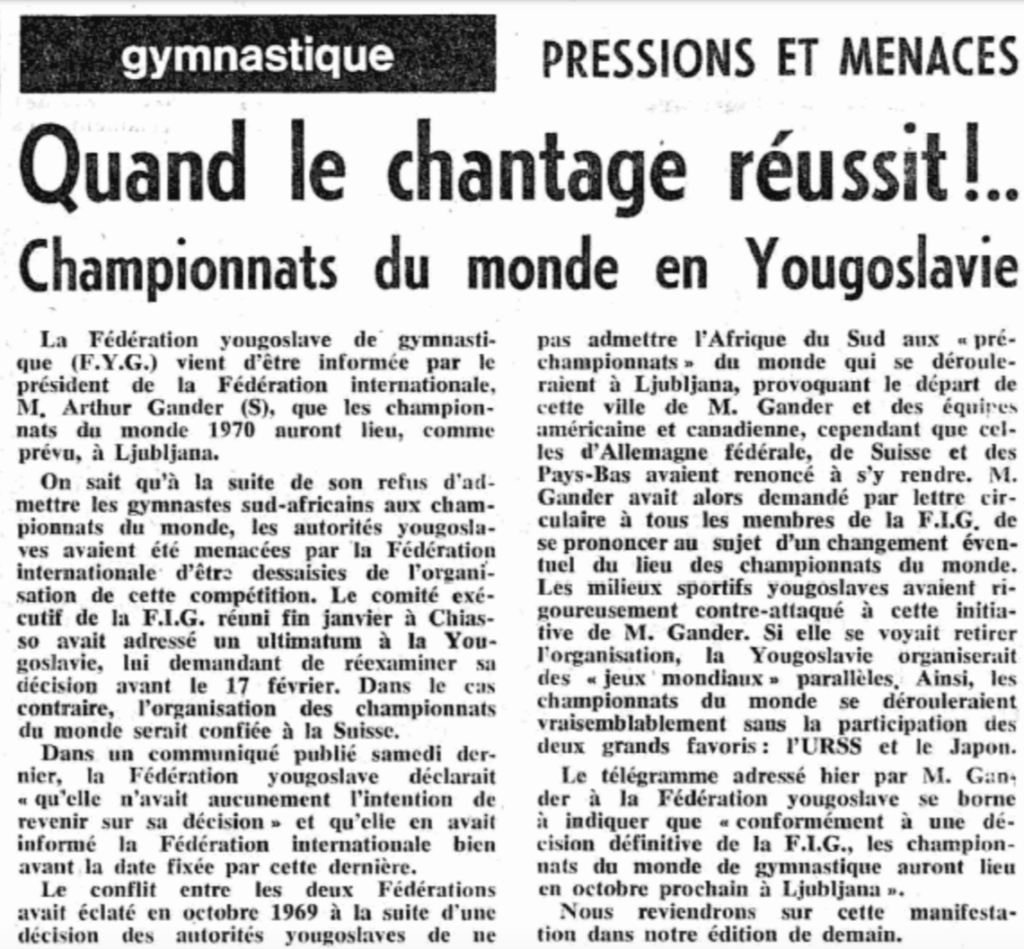In my post about the men’s technical committee meeting, I noted that Arthur Gander had been voted the next president of the FIG, replacing Charles Thœni.
Let’s take a look at some of the key decisions that were made during the FIG Congress in Dortmund.
As we go through the information, try to guess which decisions became a thorn in Arthur Gander’s side.

Decision 1
Arthur Gander was elected the President of the FIG.
- Charles Thœni was unanimously appointed Honorary President of the FIG.
- Other candidates for the presidency included Kondo Akashi (Japan), Alphonse Lacourt (Belgium), Klas Thoresson (Sweden), and Berthe Villancher (France).
- Note: It is interesting that Berthe Villancher (President of the Women’s Technical Committee, 1956-1972) was a candidate in 1966. To date, there’s never been a female president of the FIG.
Decision 2
Max Bangerter became Secretary-General of the FIG.
Decision 3
Yugoslavia would host the 1970 World Championships. (Other possibilities for host countries included Romania and Austria.)
Decision 4
Basel, Switzerland would host the 1969 Gymnaestrada. (Gymnaestrada is essentially a celebration of gymnastics in all its forms without competition or medals.)
Decision 5
Ecuador’s, Cambodia’s, and Hong Kong’s applications for membership in the Federation were accepted.
Decision 6
The United Arab Republic (which is not present-day United Arab Emirates) and Israel were not allowed to participate in the European Championships.
Decision 7
The Soviet Union motioned to exclude South Africa from the official FIG championships because of apartheid. That motion was rejected.
- Reminder: At the 1964 FIG Congress, the Congress forbid, within the FIG, the discrimination towards a country for political, religious, and racial motives (100 Years of the FIG).
- Reminder: In non-gymnastics politics, the Soviet Union and South Africa weren’t on good terms. (You can read more about that here.)
- Looking ahead: In April of 1968, the IOC withdrew its invitation to South Africa to participate in the Mexico City Olympics.
- Looking ahead: At the 1968 FIG Congress, the Soviet Union would once again motion to exclude South Africa.
- The South African delegation stated that there was no discrimination in gymnastics in their country.
- This time, the South African Delegation invited two members of the FIG (one Soviet and one representing the FIG), all expenses paid, to examine the situation in South Africa.
- The Soviet Union withdrew its proposal until the investigation could be completed (Mademoiselle Gymnast, Sept/Oct 1968)
Decision 8
In a joint Romania-Soviet Union motion, the two countries asked that the FIG refrain from hosting championships in countries that would not present the flags and emblems of every participating country. This was rejected.
- Back story: This motion was aimed at West Germany, which refused to recognize the East German regime and its emblem. (Reminder: East Germany was the communist side, and the 1966 World Championships were being held in West Germany.)
Which decisions became a pain in Arthur Gander’s side?
Probably all of them, but I was thinking of the following:
Decision 3
Hosting the 1970 World Championships in Yugoslavia
Decision 7
Recognizing South Africa as a member of the federation in spite of apartheid
Why did those decisions become a pain in Arthur Gander’s butt?
Here’s the abridged version.
There was a “Pre-World Gymnastics Championships” set to take place in Yugoslavia in October of 1969. It was meant to be a qualifying event for the 1970 World Championships, which were to be held in Yugoslavia, as well.
But the FIG canceled the qualifying event one day before it was supposed to begin.
Note: The video doesn’t have any sound.
In the clip above, you can see Cerar, Noack, Krajčírová, Lazakovich, Kasamatsu, and Kenmotsu.
They still competed. That’s because, despite the FIG’s cancellation, the event still went on. It simply wasn’t a qualifying meet for the 1970 World Championships.
Wait, what?
Here’s more detail on what happened…
No South Africans for Pre-Worlds
The Yugoslav government decided that it would not allow the South African gymnasts into the country for the Pre-World Gymnastics Championships in 1969 (L’Express, October 18, 1969).
- As a result, the American and Canadian teams, as well as Arthur Gander, left Ljubljana.
- The teams for West Germany, the Netherlands, and Switzerland indicated via telegraph that they would not travel to Ljubljana.
- The Japanese delegation indicated that it intended to leave Ljubljana, but it didn’t.
A Threat
After canceling the 1969 “Pre-Worlds,” the FIG’s Executive Committee decided to issue an ultimatum to the Yugoslav government:
If all members of the FIG didn’t have the opportunity to participate in the 1970 World Championships, the event would move to Switzerland (L’Impartial, January 30, 1970).
We’ll host our own Worlds then
The Yugoslav federation threatened to organize its own parallel World Championships if the FIG moved the event (L’Express, February 24, 1970)
Just Kidding. Worlds in Yugoslavia
The FIG finally relented, and, in a telegram, Gander stated, “In accordance with a final decision of the FIG, the world gymnastics championships will take place next October in Ljubljana.” (L’Express, February 24, 1970)

No South Africans
Gymnasts from South Africa didn’t compete at the 1970 World Championships.
Moral of the Story
If you want to be a gym nerd, always read the notes from the FIG Congress.
Always.